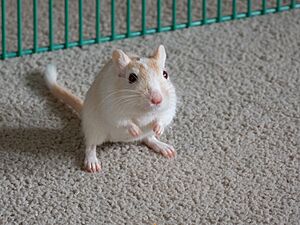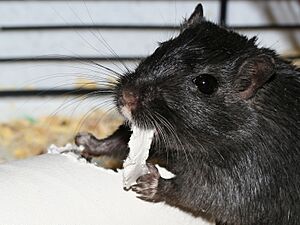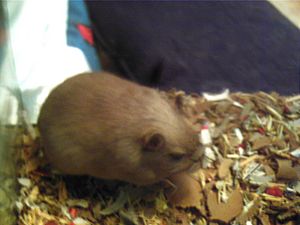Mongolian gerbil facts for kids
Quick facts for kids Mongolian gerbil |
|
|---|---|
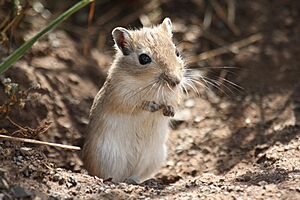 |
|
| Wild gerbil in Mongolia | |
| Conservation status | |
| Scientific classification | |
| Genus: |
Meriones
|
| Species: |
unguiculatus
|
The Mongolian gerbil (Meriones unguiculatus) is a small rodent that belongs to the Gerbillinae family. These animals are often kept as small house pets. They are also sometimes used in scientific research.
Mongolian gerbils are usually about 11 to 13.5 centimeters (4 to 5 inches) long. Their tails add another 9.5 to 12 centimeters (3.7 to 4.7 inches) to their length. They weigh between 60 and 130 grams (2 to 4.5 ounces). Adult male gerbils are typically larger than females.
Gerbils were first used in science in the late 1800s. They became popular pets in English-speaking countries after 1954, when they were brought to the United States. However, they are not used as much in scientific research today.
Contents
Where Do Gerbils Live?
Mongolian gerbils live in grasslands, shrublands, and deserts. You can find them in countries like China, Mongolia, and Russia.
The soil in these areas is often sandy. It is covered with grasses, herbs, and shrubs. These places have cool, dry winters and hot summers. Temperatures can reach up to 50°C (122°F). However, the average temperature for most of the year is around 20°C (68°F).
In the wild, gerbils live in family groups. These groups usually have one parent pair, their newest babies, and some older young. Sometimes, the dominant female's sister might also live with them. Only the main female in the group will have babies. She mostly mates with the main male. Female gerbils are usually more loyal to their partners than males. A group of gerbils usually uses an area between 325 and 1550 square meters (388 to 1854 square yards).
A gerbil group lives in a main burrow. This burrow can have 10 to 20 exits. They might also have smaller, deeper burrows with only a few exits. These smaller burrows help them escape from predators if they are far from the main home. Different gerbil groups often connect their burrows underground.
Gerbils in Science
Gerbils have been used in scientific research for a long time. However, they are not used as much today. For example, in the United Kingdom in 2017, only about 300 Mongolian gerbils were used in studies. This is much less than the over 2 million mice used.
How Lab Gerbils Started
Most gerbils used in science today come from a group called the Tumblebrook Farm strain. This group started with 20 wild Mongolian gerbils. They were sent to Japan in 1935. Eleven of these gerbils were later sent to Dr. V. Schwentker's Tumblebrook Farm in New York, United States, in 1954. More gerbils were sent to Charles River Ltd in Italy in 1996.
Gerbil Hearing and Sounds
Gerbils can hear a wide range of sounds. They can hear low sounds, like foot drumming, and high-pitched chirps. This makes them good animals to study human hearing loss. Mice and rats are not as good for this because they mostly hear high-frequency sounds.
Male gerbils can make very high-pitched sounds called ultrasonic sounds. These sounds are too high for humans to hear. They use these sounds to communicate with each other, especially when they are around other gerbils. Dominant males tend to make more sounds than others.
Gerbils and Health Studies
Gerbils can sometimes have epileptic seizures. This happens to about 10-20% of gerbils. These seizures usually occur when they are stressed, like when they are handled or their cage is cleaned. Scientists have even bred gerbils that are more likely to have seizures and those that are less likely.
Like some other desert rodents, Mongolian gerbils can get diabetes if they eat certain foods. This is not very common, but scientists have created a group of gerbils that are more likely to get diabetes. This shows that genetics play a role in gerbil diabetes.
Gerbil Genetics
Scientists study the genes of gerbils. Lab gerbils came from a small number of original gerbils. So, people used to think they didn't have much genetic variety. However, newer studies looking at their whole genome show that they actually have a lot of genetic diversity. In 2018, scientists published the full genetic code of the Mongolian gerbil.
Gerbil Behavior
Gerbils are social animals. They live in groups in the wild. They use their strong sense of smell to recognize other gerbils from their own group. Gerbils are known to attack or even kill other gerbils that smell unfamiliar to them. In groups, there is often a "dominant" gerbil that might try to show its power over the others.
Gerbils as Pets
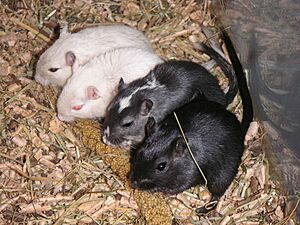
The Mongolian gerbil is a gentle and strong animal. This has made it a popular small house pet. They were first brought from China to Paris in the 1800s and became popular pets there. Later, in 1954, Dr. Victor Schwentker brought them to the United States for research. He soon realized they would make great pets.
Over time, people have bred gerbils to have many different colors and patterns. Gerbils became popular pets in the U.S. in the late 1950s. They were brought to the United Kingdom in 1964 and also became popular there. Today, you can find them in pet shops in many places.
However, it is against the law to buy, bring in, or keep a gerbil as a pet in the U.S. state of California. This is because they could harm the local environment and farms. It is also illegal to bring them into New Zealand and Australia.
Gerbils are usually not aggressive. They rarely bite unless they are scared or stressed. They are small and easy to handle. Gerbils are social and enjoy being with humans and other gerbils. They are also very clean animals and don't have much odor. This is because their bodies are good at saving water and producing very little waste. Gerbils come in many beautiful coat colors and patterns.
Common Health Issues for Pet Gerbils
Gerbils can have some health problems. Here are a few:
- Tooth problems: Their front teeth (incisors) can grow too long if they are injured or don't get the right food. This can hurt the roof of their mouth. Signs include not eating, drooling, losing weight, or bad breath.
- Injuries: Gerbils can get hurt if they are dropped or fall, especially from things like hamster balls. This can cause broken bones, which are hard to treat.
- Neglect: Like all small pets, gerbils need proper care. If they don't get enough food and water, they can become dehydrated, starve, or get stomach problems.
- Seizures: Between 20% and 50% of pet gerbils can have seizures. These are often caused by fright, being handled, or being in a new place. The seizures can be mild or severe. They usually don't cause long-term problems, but very severe ones can sometimes lead to death. To help prevent seizures, avoid blowing in a gerbil's face. This is sometimes done in labs to cause seizures for research.
- Tumors: Both harmless and harmful growths (tumors) are common in pet gerbils. They are most often seen in females over two years old. Tumors can appear in the ovaries, making the belly look big, or on the skin, often around the ears, feet, belly, or tail base.
- Tail loss: Gerbils can lose their tails if they are handled incorrectly, attacked by another animal, or if their tail gets stuck. The fur might fall off the tip of the tail first. Then, the skinless part of the tail dies and falls off. The remaining part usually heals well.
- Tyzzer's disease: This is a common bacterial infection in gerbils. Stress can make them more likely to get it. Symptoms include ruffled fur, being tired, hunched posture, not eating much, and diarrhea. It often leads to death and spreads quickly between gerbils that are close to each other.
- Ear problems: An inner ear problem can make a gerbil lean to one side. This might be caused by ear infections. Gerbils with certain white markings are more likely to be deaf. This is thought to be because of a lack of color in and around their ears.
Different Types of Pet Gerbils
Today, you can find many different colors of gerbils in pet shops. These colors have been created over years through selective breeding.
The Mongolian gerbil, which has been kept as a pet for the longest time, has over 20 different coat colors.
Another type of gerbil kept as a pet is the fat-tailed gerbil (Pachyuromys duprasi). These are smaller than Mongolian gerbils. They have soft fur and short, fat tails, making them look a bit like a hamster.
Images for kids
See also
 In Spanish: Gerbil de Mongolia para niños
In Spanish: Gerbil de Mongolia para niños




